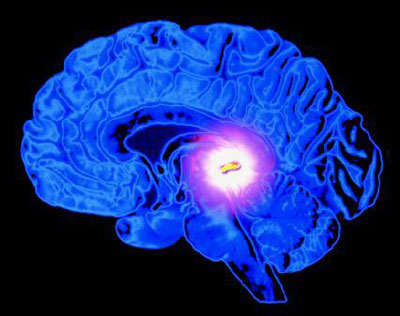The Human Antenna
by admi, bibliotecapleyades.net| from TheIntentionExperiment Website No one quite knows what to make of the pineal gland. This cone-shaped pea of a gland sits on the roof of the third ventricle of the brain, directly behind the root of the nose, floating in a small lake of cerebrospinal fluid. Because it lies in the center of the brain, neurosurgeons and radiologists have found it a useful landmark for brain surgery.  But until relatively recently, it was the subject of much lore as the gateway into the soul or the higher realm, the memory valve, an energy vortex, the main tap for vital fluids and even the source of mental illness. It was philosopher René Descartes, who first laid claim to the idea that the pineal gland is the seat of the soul, a unique meeting point between body and soul. In modern times, the gland has been consigned to the neurological dustbin, regarded by the scientific community as an evolutionary leftover, the appendix of the brain. The pineal has been called a photo-neuroendocrine transducer, through which a neural signal with environmental information is converted into a chemical message - in this case, to switch on or off the production of melatonin.
Although scientists realize that the pineal is light-sensitive, it has always been assumed that the light or darkness enters as usual from the rod and cone receptors in the eye retina and makes its way to the gland via the sympathetic nerves. The conventional wisdom is that a small percentage of the impulses from the optic nerve are detoured to the pineal from the visual pathway, and it is this input which controls the production of melatonin. Researcher Serena Roney-Dougal has gathered together some of the most compelling research into the biological means by which the geomagnetic flux of the earth might cause the pineal gland to allow us to psychically ‘tune in’.
This is akin to what doctors claim is the action of selective serotonin reuptake inhibitors (SSRIs) like Prozac. Some evidence also suggests that the pineal can also manufacture an hallucinogenic substance called 5-methoxydimethyltryptamine (5-methoxy-DMT) from melatonin. What might be the result is a pooling of these amines into the synapses of the brain, causing reactions that are similar to drug-induced hallucinations. The current view is that neuromodulators need 5-methoxy-DMT and DMT in order to work and that, by blocking MAO, the pineal gland regulates and increases the concentration of serotonin. This regulatory function of blocking one chemical and promoting another is thought to be the catalyst for dreaming. Several facts suggest that the production of serotonin and melatonin may be in some way involved in psychic phenomena. First, many hallucinogenic substances are chemical sisters to those made by the pineal gland. Yage, or ayahuasca, a ceremonial drink made by some Amazon tribes to produce psychic effects for healing, clairvoyance and precognition, is produced from native vines (Banisteriopsis caapi) that are chemically nearly equivalent to the 5-methoxy-DMT in humans.
So, how could the earth’s geomagnetic fluctuations affect these brain chemicals? Researchers have found that electromagnetic and geomagnetic fields strongly affect the production and activity of the enzyme hydroxyindole-O-methyltransferase (HIOMT). It is this enzyme that is centrally involved in the production of melatonin and possibly 5-methoxytryptamine (5-MT). Any changes in the the magnetic field can produce changes in this enzyme’s activity. Studies in animals have also shown that any strong change in the ambient magnetic field - whether increased or decreased - will inhibit production of HIOMT. Other research shows that serotonin N-acetyltransferase, the enzyme involved in the production of melatonin, is strongly affected by electromagnetic fields. If this is the case, says Roney-Dougal, any strong change in the earth’s ambient magnetic field would produce a rush of natural hallucinogens in our bodies, enabling us to be more psychically receptive.
In one such study, the famous parapsychologist Stanley Krippner set up a dream laboratory where some participants slept in a room while other participants attempted to ‘send’ them certain images in hopes that these images would become incorporated into the sleeping participants’ dreams. Upon waking, the sleepers had to describe their dreams in great detail to determine if there were any correlations with the target pictures they’d been ‘sent’ during their slumbers. Global geomagnetic activity was tracked for 20 of the nights that one study participant was the dreaming recipient. In this case, it was found that, on nights of less geomagnetic activity, the dreamer had significantly greater accuracy in picking up the target pictures. It may well be that our human potential is at its greatest when we are in harmony with the earth and the sun. Traditional cultures had some greater understanding of this energetic harmony that we do well to learn from. |
Original Page: http://www.bibliotecapleyades.net/ciencia/ciencia_brain11.htm
Shared from Read It Later
Comments
Post a Comment